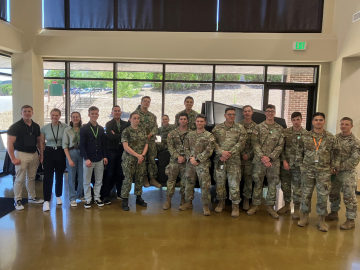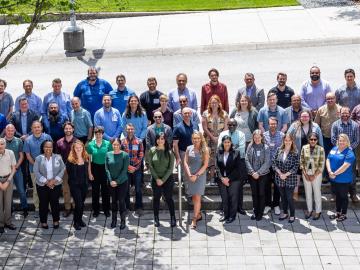
Filter News
Area of Research
- Advanced Manufacturing (4)
- Biological Systems (2)
- Biology and Environment (70)
- Clean Energy (55)
- Computational Biology (2)
- Computational Engineering (2)
- Computer Science (5)
- Electricity and Smart Grid (1)
- Fuel Cycle Science and Technology (1)
- Functional Materials for Energy (1)
- Fusion and Fission (11)
- Fusion Energy (8)
- Isotope Development and Production (1)
- Isotopes (27)
- Materials (65)
- Materials for Computing (6)
- National Security (53)
- Neutron Science (35)
- Nuclear Science and Technology (23)
- Nuclear Systems Modeling, Simulation and Validation (1)
- Quantum information Science (3)
- Supercomputing (77)
News Topics
- (-) Advanced Reactors (34)
- (-) Bioenergy (92)
- (-) Biomedical (59)
- (-) Cybersecurity (35)
- (-) Frontier (44)
- (-) Isotopes (54)
- (-) Machine Learning (48)
- (-) National Security (67)
- (-) Physics (63)
- (-) Space Exploration (25)
- 3-D Printing/Advanced Manufacturing (125)
- Artificial Intelligence (95)
- Big Data (58)
- Biology (100)
- Biotechnology (23)
- Buildings (59)
- Chemical Sciences (68)
- Clean Water (30)
- Climate Change (101)
- Composites (29)
- Computer Science (194)
- Coronavirus (46)
- Critical Materials (28)
- Decarbonization (81)
- Education (4)
- Element Discovery (1)
- Emergency (2)
- Energy Storage (110)
- Environment (197)
- Exascale Computing (39)
- Fossil Energy (6)
- Fusion (55)
- Grid (65)
- High-Performance Computing (88)
- Hydropower (11)
- Irradiation (3)
- ITER (7)
- Materials (144)
- Materials Science (143)
- Mathematics (9)
- Mercury (12)
- Microelectronics (3)
- Microscopy (51)
- Molten Salt (8)
- Nanotechnology (60)
- Net Zero (14)
- Neutron Science (132)
- Nuclear Energy (110)
- Partnerships (49)
- Polymers (33)
- Quantum Computing (35)
- Quantum Science (69)
- Renewable Energy (2)
- Security (24)
- Simulation (49)
- Software (1)
- Statistics (3)
- Summit (59)
- Sustainable Energy (129)
- Transformational Challenge Reactor (7)
- Transportation (97)
Media Contacts

Benjamin Manard, an analytical chemist in the Chemical Sciences Division of the Department of Energy’s Oak Ridge National Laboratory, will receive the 2024 Lester W. Strock Award from the Society of Applied Spectroscopy.

Ten future U.S. Army officers recently visited ORNL to learn about the legacy of nuclear science. As students of the Nuclear Science and Engineering Research Center, or NSERC, with the Defense Threat Reduction Agency, or DTRA, they stopped in East Tennessee as part of a larger tour across nuclear facilities supporting the military. In Oak Ridge, they visited ORNL to gain an appreciation of the history of the Manhattan Project and how research at a national lab contributes new materials and electronics for the nuclear industry.

Scientists have determined that a rare element found in some of the oldest solids in the solar system, such as meteorites, and previously thought to have been forged in supernova explosions, actually predate such cosmic events, challenging long-held theories about its origin.

The world’s fastest supercomputer helped researchers simulate synthesizing a material harder and tougher than a diamond — or any other substance on Earth. The study used Frontier to predict the likeliest strategy to synthesize such a material, thought to exist so far only within the interiors of giant exoplanets, or planets beyond our solar system.
Joe Tuccillo, a human geography research scientist, leads the UrbanPop project that uses census data to create synthetic populations. Using a Python software suite called Likeness on ORNL’s high-performance computers, Tuccillo’s team generates a population with individual ‘agents’ designed to represent people that interact with other agents, facilities and services in a simulated neighborhood.

Brian Sanders is focused on impactful, multidisciplinary science at Oak Ridge National Laboratory, developing solutions for everything from improved imaging of plant-microbe interactions that influence ecosystem health to advancing new treatments for cancer and viral infections.
The contract will be awarded to develop the newest high-performance computing system at the Oak Ridge Leadership Computing Facility.

ORNL hosted the Mid-South Regional Chapter of the American Society for Photogrammetry and Remote Sensing, or ASPRS. Participants spanning government, academia and industry engaged in talks, poster sessions, events and workshops to further scientific discovery in a field devoted to using pictures to understand changes to the earth’s inhabitants and landscape.

Researchers conduct largest, most accurate molecular dynamics simulations to date of two million correlated electrons using Frontier, the world’s fastest supercomputer. The simulation, which exceed an exaflop using full double precision, is 1,000 times greater in size and speed than any quantum chemistry simulation of it's kind.

A newly established internship between ORNL and Maryville College is bringing cybersecurity careers to a local liberal arts college. The internship was established by a Maryville College alumni who recently joined ORNL.


